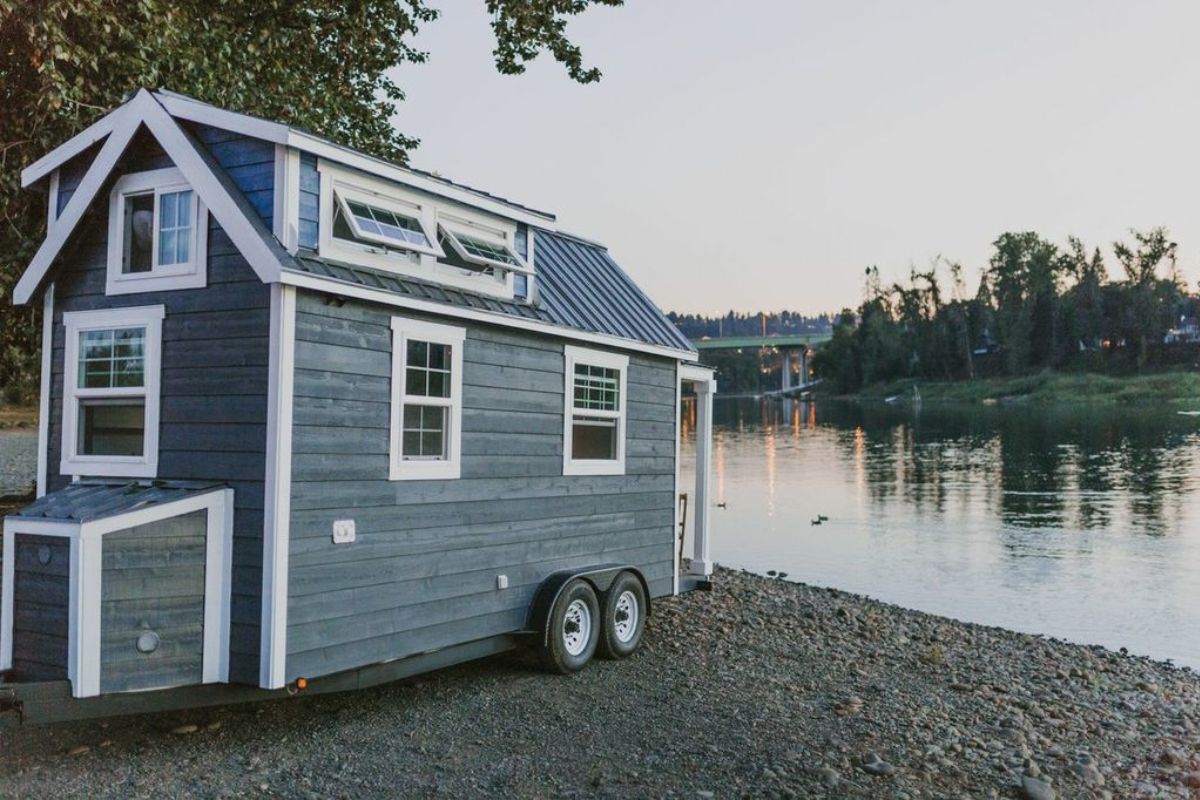Living in a tiny house can present some unique challenges that may not be immediately obvious, and a lack of awareness about these challenges could lead to preventable accidents or dangerous situations. This is why personal safety should be a priority for anyone considering or already living in a tiny house. Below, we explore key factors that affect safety in tiny homes and what can be done to mitigate potential risks.
1. Space Efficiency and Safety
One of the defining features of tiny houses is their efficient use of space. With limited square footage, every inch must be utilized effectively. Tiny homes are typically between 100 and 400 square feet, requiring residents to make the most of compact areas. This design approach can have both positive and negative effects on safety, depending on how the space is managed.
Positive Impact: The compact design often results in fewer areas where accidents can occur. For example, in traditional homes with multiple rooms and open floor plans, it’s easier to trip over objects or encounter obstacles in high-traffic areas. In contrast, tiny homes usually have fewer things to bump into or trip over. Additionally, a well-organized tiny house may reduce clutter, creating a more streamlined living environment that can minimize the risk of accidents.
For instance, a streamlined kitchen area with appliances and tools neatly stored away reduces the likelihood of cuts or burns. Likewise, a compact bathroom with secured fixtures reduces slipping hazards. The limited space also means less room for scattered belongings, which can contribute to fewer tripping accidents.

Negative Impact: On the flip side, tiny houses’ limited space can introduce certain safety concerns, particularly during emergencies. For example, the close quarters can lead to challenges such as limited escape routes in the event of a fire or other emergencies. In a traditional home, there are often multiple exits and larger hallways that can facilitate a quick escape, but in a tiny house, blocked or narrow exits could lead to dangerous delays in evacuation.
Ensuring that exits are easily accessible and free from obstructions is crucial for safety. In addition, the lack of space may lead to overcrowding of essential items like tools, personal belongings, or food supplies, which could block pathways or emergency exits. Keeping the space as open as possible and removing non-essential clutter is key to making sure safety is maintained.
Another consideration is the layout of lofts or elevated sleeping areas. Many tiny homes use lofts as bedrooms to maximize space, but this creates a risk of falling, particularly if the lofts lack proper guardrails or ladders. Ensuring that lofts are designed with secure railings and safe access points can reduce the risk of injury.
2. Fire Safety Considerations
Fire protection is a significant concern in any home, but tiny houses have unique risks due to their size and design. Fires can spread quickly in a tiny house, and because of the compact space, residents have less time to react and evacuate.
Building Materials: Many tiny houses are constructed using lightweight materials that may not offer the same fire resistance as traditional homes. It’s essential to use fire-rated materials where possible, particularly in areas like the kitchen and around heating sources. Additionally, all electrical installations should meet current safety standards to avoid the risk of electrical fires.
Heating Systems: Heating is another concern, as tiny houses often rely on space heaters, propane stoves, or small wood-burning stoves for warmth. These systems must be installed properly, with adequate ventilation and clearance from flammable materials. It’s crucial to regularly maintain and inspect heating systems to ensure they are functioning safely and to follow the manufacturer's guidelines for use.
In colder climates, tiny homes may rely more heavily on portable heating units, which can be a significant fire hazard if not used correctly. Keeping heaters away from curtains, furniture, and other flammable items is crucial. Tiny house residents should also ensure that heaters are placed on stable surfaces and that they are turned off when not in use.
Smoke Alarms and Fire Extinguishers: In a tiny house, installing multiple smoke alarms is vital, given the limited square footage. Because of the compact space, fires can spread incredibly fast, leaving little time for residents to react. Smoke alarms should be placed in key areas, such as the kitchen, sleeping areas, and near any heating equipment. Having accessible fire extinguishers is also essential for combating small fires before they grow out of control. Because residents may not have time to wait for firefighters, having these safety devices in place can be life-saving.
Consider installing a carbon monoxide detector as well, especially if the house uses gas-powered appliances. Poor ventilation can lead to a build-up of carbon monoxide, which is odorless and deadly.

3. Structural Integrity and Safety
The structural integrity of a tiny house is critical for ensuring personal safety, especially given the non-traditional designs and materials often used. Unlike conventional homes built on solid foundations, many tiny houses are constructed on trailers to enable mobility. This can introduce additional concerns regarding the strength and durability of the structure.
Foundation: A stable foundation is essential for any home, tiny or large. If the tiny house is on a trailer, it’s vital to ensure that the trailer is in good condition and capable of supporting the weight of the house. Tiny houses built on wheels must also be secured properly when parked to prevent movement during high winds or other adverse weather conditions. If the home is on a fixed foundation, it’s important to make sure that the foundation is level, secure, and capable of supporting the structure's weight over time.
Weight Distribution: Weight distribution is another key factor in maintaining the structural integrity of tiny houses, particularly those built on trailers. If weight isn’t evenly distributed across the trailer, it can lead to tipping or instability, which is especially dangerous when the house is in motion.
Tiny houses built on flexible bases like trailers must incorporate secure design features to maintain structural safety, and using accessories like flange wedges can aid in stabilizing these structures.
Securing heavy items like appliances and furniture is also crucial to prevent shifting during transport or while stationary. Failure to do so can lead to accidents both on the road and when the house is parked.
Ventilation: Proper ventilation is critical in tiny houses to avoid issues like mold and to ensure good air quality. Because tiny houses have such limited space, they can easily become stuffy, leading to condensation and the growth of mold or mildew. Installing effective ventilation systems, such as exhaust fans or air vents, can help mitigate these risks. Additionally, having enough windows to allow for natural air circulation can help maintain a healthy living environment.
4. Emergency Preparedness
Living in a tiny house requires unique considerations for emergency preparedness. Because of the compact space and potential for hazards like fires or structural instability, residents must be prepared to handle emergencies quickly and efficiently.
Emergency Plans: Having a clear emergency plan is essential in a tiny house. All occupants should be familiar with the location of exits, fire extinguishers, and other emergency supplies. Practicing escape routes regularly can help ensure that everyone knows how to exit the house quickly in case of an emergency.

First Aid Kits: A well-stocked first aid kit is essential in any home but can be especially important in a tiny house where medical supplies may be harder to access. The first aid kit should include bandages, antiseptic wipes, and any necessary medications. Ensuring that the kit is easy to access and well-organized is crucial for handling minor injuries effectively.
Natural Disasters: Tiny house residents should also be prepared for natural disasters, such as floods, hurricanes, or wildfires, especially if the home is mobile. Having a plan for securing the house or evacuating the area quickly can make a significant difference in an emergency.
5. Safety for Tiny House Residents
The safety of tiny house residents extends beyond the physical structure. Incorporating additional safety features and adhering to local regulations can help ensure that tiny house living remains safe for all occupants.
Safety Features: Loft areas should have secure railings, and stairs or ladders should be sturdy and safe to use. If children are present, childproof locks and other safety measures should be implemented to prevent accidents. Non-slip flooring is another key feature that can reduce the risk of falls, particularly in areas like the kitchen and bathroom.
Insurance and Regulations: It’s essential to ensure that your tiny house meets local building codes and regulations. While tiny houses often exist in a legal gray area, meeting safety standards can provide peace of mind. Additionally, having the right insurance coverage is crucial to protect against accidents, natural disasters, or other emergencies.
In the event of a serious incident, consulting with a local personal injury attorney can provide guidance on navigating legal issues and ensuring your rights are protected. This is especially important if the house is damaged due to faulty construction or another party's negligence.






Share: